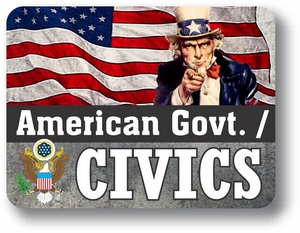American Government/Civics

Course Overview:
This Civics / American Government course will cover important topics related to the structure and function of our government from the nation’s founding to the present. Key topics include the origins of American government and founding documents; how campaigns and elections work; the role and functions of American institutions such as Congress, the Presidency, the court system, and the bureaucracy; the role and impact of mediating institutions such as the media, political parties, interest groups, and technology; how domestic public policy and foreign policy are shaped; and last, the role of citizens in a changing democracy.
The course is structured to inform students about the structure and function of government to prepare them to be active and engaged citizens in our democracy. Students will be challenged to apply their acquired knowledge by completing a variety of assessments, interactive simulations, and writing assignments. This multifaceted approach to learning reinforces the course material while polishing students’ reading, writing, and communication skills.
Prerequisites:
- United States History Semester 1 Recommended
- United States History Semester 2 Recommended
- World History Semester 1 Recommended
- World History Semester 2 Recommended
Syllabus:
Section 1:The Origins of American Government and the Role of Citizens
In this section the students will learn about:
- Different types of government that existed in the past, as well as the present.
- The reasons for why it is important to study government, particularly in a democratic political system like the United States.
- The basic structure of American government and civic engagement: who governs and the role of civic participation and engagement in American government.
- The historical context in which the U.S. government was created, including the pre-revolutionary period, the intellectual roots of the American political system, and the early Articles of Confederation that preceded the U.S. Constitution.
- The historical context for the creation of the U.S. Constitution and the Bill of Rights, as well as the core features of both founding documents.
- The concept and application of federalism in American government, as laid out in the U.S. Constitution.
Lessons:
- What Is Government and Why Should We Study It?
- Politics, Power, and Participation in American Government
- The Origins of the U.S. Constitution
- The U.S. Constitution and the Bill of Rights
- American Federalism
Section 2: Individual Agency and Action
In this section, you will learn about:
- The civil liberties guaranteed to Americans, as laid out in the U.S. Constitution and the Bill of Rights
- The origins of civil liberties in the U.S. context.
- The concept of civil rights and the struggle to secure equal civil rights for discriminated groups in the United States.
- How citizens participate in American government by running for office and voting for candidates.
- How public opinion interacts with and influences American politics.
- Political socialization: the process by which citizens usually form political beliefs and preferences.
Lessons:
- Civil Liberties
- Civil Rights
- Campaigns, Elections, and Voting
- Public Opinion and Politics
Section 3: Institutions of American Government
In this section, you will learn about:
- The structure and role of Congress; the process of Congressional elections; and the legislative process.
- The design of the executive branch, the presidential election process, and the roles and responsibilities of the presidency.
- The design and evolving role of federal courts in the United States since the ratification of the U.S. Constitution.
- The evolution of public administration in American government and key functions performed by bureaucratic agencies.
- The division and balance of power between state and local government, as well as their varying roles and responsibilities.
Lessons:
- Congress
- The Presidency
- The Courts
- The Bureaucracy
- State and Local Government
Section 4: Mediating Institutions in American Government
In this section, you will learn about:
- How the media are organized in the United States, the function of the media in a free society, the evolution of the media, and the impact of the media on American politics.
- How political parties formed in the United States, including the evolution of the two-party system, and growing political polarization along party lines.
- What public and private interest groups are, and how they interact with and impact the political process in the United States.
- The 21st-century technological revolution: how technology has changed and continues to change the political arena and is transforming the way governments govern.
Lessons:
- The Media
- Political Parties
- Interest Groups and Lobbying
- Politics and Technology
Section 5: Public Policy and Civic Engagement in a Changing Democracy
In this section, you will learn about:
- What public policy is, the individuals and groups who play a role in shaping public policy, and the process in the United States that a policy must navigate to go from idea to implemented public policy.
- Domestic policy in the United States, including a broad range of issues related to the economy, environment, and education.
- The national budget and tax issues that serve as the fiscal foundation for creating any public policy in the United States.
- The objectives and strategic application of American foreign policy, as well as the officials and agencies that shape foreign policy.
- The expanding roles and civic responsibilities of Americans in a dynamic democracy.
- The importance of critical thinking skills and civic engagement in a democracy.
Lessons:
- Shaping Public Policy in the United States
- Domestic Policy in the United States
- Foreign Policy and National Security
- Civic Engagement in a Changing Democracy


